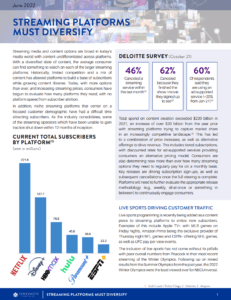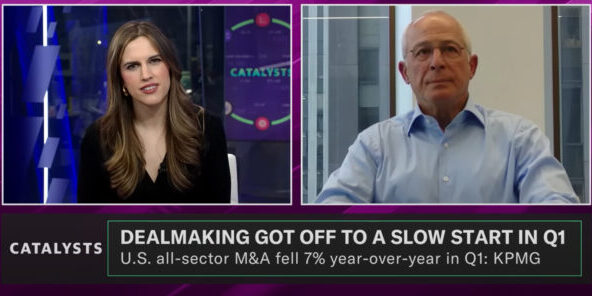Streaming Platforms Must Diversify
Streaming Platforms Must Diversify
Streaming media and content options are broad in today’s media world with content undifferentiated across platforms. With a diversified slate of content, the average consumer can find something to watch on each of the larger streaming platforms. Historically, limited competition and a mix of content has allowed platforms to build a base of subscribers while growing content libraries. Today, with more options than ever, and increasing streaming prices, consumers have begun to evaluate how many platforms they need, with no platform spared from subscriber attrition. In addition, niche streaming platforms that center on a focused customer demographic have had a difficult time attracting subscribers. As the industry consolidates, some of the streaming operators which have been unable to gain traction shut down within 12 months of inception.
Total spend on content creation exceeded $220 billion in 2021, an increase of over $20 billion from the year prior with streaming platforms trying to capture market share in an increasingly competitive landscape. This has led to a combination of price increases, as well as alternative offerings to drive revenue. This includes tiered subscriptions, with discounted rates for ad-supported services providing consumers an alternative pricing model. Consumers are also determining now more than ever how many streaming options they need to regularly pay for on a monthly basis. Key releases are driving subscription sign-ups, as well as subsequent cancellations once the full viewing is complete. Platforms will need to further evaluate the appropriate release methodology (e.g., weekly, all-at-once or something in between) to continuously engage consumers.
Live sports programming is recently being added as a content piece to streaming platforms to entice new subscribers. Examples of this include Apple TV+ with MLB games on Friday nights, Amazon Prime being the exclusive provider of Thursday night NFL games and ESPN+ offering NHL games, as well as UFC pay-per-view events.
The inclusion of live sports has not come without its pitfalls with poor overall numbers from Peacock in their most recent streaming of the Winter Olympics. Following up on mixed results from the Summer Olympics from the past year, the 2022 Winter Olympics were the least viewed ever for NBCUniversal.
Despite the overall decline in viewership, these Olympics were the most streamed Olympics ever, with 4.5% of the total primetime audience streaming.
Ease of use is a common roadblock as both providers and sports leagues experiment with the ideal way to reach audiences. While younger audiences may be more likely to adapt to multiple viewing platforms, aging consumers may struggle to find their favorite team on alternative services. Platforms and leagues will need to balance “exclusive” content with accessibility for all viewers.
We believe the streaming platforms that repeatedly add both live and on-demand content will become the “go-to” streaming platform for consumers. The key for streaming platforms is to evaluate the routines of their consumers and become the instinctual program that is turned on when a consumer returns home from work or is starting the day. Streaming platforms will also need to integrate or compete with out-of-home entertainment experiences with consumers becoming more and more comfortable venturing to physical locations. It is important that streaming platforms are accessible anywhere and any place at any time.
One effort to continuously expand customer bases is bundled packaging where streaming platforms are combining their services to increase content offering. Verizon’s Plus Play combines services like Netflix, Disney+, Discovery+, and others into a single platform. This seems to be trending toward something that looks like a traditional cable package with a collection of the various platforms concentrated in one location.
Alternatively, platforms could be continuously merging into one entity with a more robust content library at disposal. After the Discovery / WarnerMedia merger, the merged company announced it will combine HBO Max and Discovery+ into one platform at a future date. This will likely not be the last merged platform in the segment. Consolidation may be the next phase for streaming platforms.
Click below to read the article from the Media & Entertainment Group.






